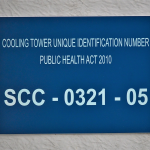A Risk Management Plan (RMP) is an important safeguard in preventing Legionnaires’ disease,  documenting best practices to control the growth and transmission of Legionella while considering the risks that are unique to the cooling water systems.
documenting best practices to control the growth and transmission of Legionella while considering the risks that are unique to the cooling water systems.
Under the new NSW Regulations, an RMP must be completed by a competent person on the approved form prescribed by NSW Health.
Who is a competent person?
A competent person (risk assessor) has:
- Sufficient to provide safe and satisfactory performance
- Appropriate training
- Practical experience in the subject
- Final sign off on the RMP
What a RMP assessment involves:
- Interviews with personnel involved in the installation, operation or maintenance of the cooling water system
- Site visits to the cooling water system, including inspection of the cooling tower
- Reviews of existing documentation, including monthly reports of inspection, maintenance (including servicing), chemical analysis and microbial testing, and operating and maintenance manuals
RMP components:
- A risk analysis for the overall risk of Legionella growth and transmission from a cooling water system is calculated by considering the residual risk for each risk factor, within each risk category, to determine the overall risk evaluation for the system. The overall residual risk determines how often a risk assessment of the cooling water system is required.
- Low risk level – RMP frequency: 1 to 5 years
This level indicates a low risk of Legionella transmission from the cooling water system
- Medium risk level – RMP frequency: 1 to 5 years
This level indicates a medium risk of Legionella transmission from this cooling water system. This level suggests that the ability of the system to inherently discourage bacterial growth is reduced.
- High risk level – RMP frequency: every year
This level indicates a high risk of Legionella transmission from this cooling water system. This level suggests that the system may be actively encouraging growth and transmission of microorganisms.
- A risk evaluation is summarised by a competent person, of the overall risk level for the cooling tower based on their judgement and technical understanding of the cooling water system. The risk level of low, medium or high is assigned for each of the five risk categories:
- Stagnant Water
- Nutrient availability and growth
- Poor water quality
- Location and access to cooling towers
- Deficiencies in the cooling water system
- A maintenance plan is developed to outline the frequency for different maintenance activities associated with the cooling water system. The Regulations requires a minimum frequency of:
- Monthly inspections
- Monthly maintenance, including servicing
- Monthly chemical analysis, including corrosion monitoring
- Monthly microbial testing (for Legionella and HCC)
- Six monthly cleaning is recommended
The competent person is required to outline the control range for risk factors required for the cooling water system.
- The competent person is required to develop an action plan to ensure the risks identified are adequately controlled, within an appropriate timeframe, with control strategies in the five risk categories. Compliance with the requirements of the action plan will be reviewed by the independent auditor every year.
- The certificate of RMP completion must be provided to the local government authority within 7 days of completion.
Contact our Legionella Control Regulations Lead, Tamsin Woods on 0499 360 049 if you have a query about the RMP process for your facility.
Read more about what’s new at HydroChem


